

 |
||||||||||||||||
| Go To Page: | 1 | 2 | 3 | 4 | 5 | 6 | 7 | Mochidex |


 |
Arai Sweets |
||||||
|
|||||||
 |
Rice Cake Gratin |
||
 Recipe:oil for sauteing 8 pieces mochi (rice cake) 1. Heat a generous amount of oil in a frying pan and |
|||
 |
Rice Cake with Chinese Sauce |
||
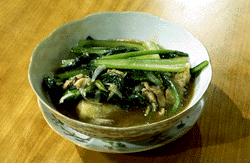 Ingredients: (4 servings) Recipe:4 pieces rice cake Oil for deep-frying 2 Tbsp. oil 1) Deep-fry rice cake at 140 to 150 C. until slightly brown. |
|||
 |
Steamed Mochi Dressed with Silver Starch Sauce |
||
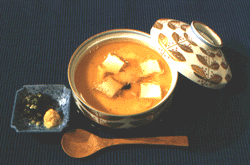 Ingredients: (4 servings) 300cc dashi (Japanese soup stock) 100cc sake, boiled off 15cc mirin, boiled off 1/3 tsp. salt 15cc light soy sauce 4 Tbsp. cornstarch dissolved in water Recipe: Professional Notes: Add the milk after the eggs are well beaten. Pass through a mesh strainer, and the egg mixture becomes smooth. Steam it over high heat at the beginning to mold quickly. When the surface turns white, reduce the heat and steam further for quite a long period of time. Steaming over high heat for a long time results in a porous finish.
|
|||
 |
Browned Rice Cake with Vegetable Starch Sauce |
||
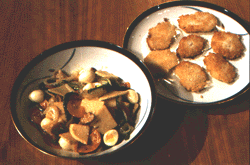 Recipe: 1. Warm the rice to the level that it can be shaped into balls by hand. |
|||
 |
Rice Cake and Usuage in Japanese Soup |
||
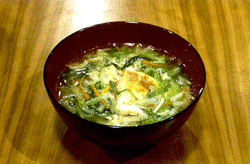 Ingredients: (4 servings) 1) Bake the rice cakes in a toaster oven. |
|||
 |
How to keep rice cakes(mochi) fresh |
|||
|
||||
 |
Kibi Mochi |
|||||||||||||||||
|
||||||||||||||||||
 |
Sakura-mochi |
||
Natural History of Hiroshima City
Japanese name: SAKURA MOCHI Sakura-mochi are wraped in the leaf of a Cherry tree. other site ( search by altavista ) || other Japanese site ( search by goo ) What is your impression of this [section]? I would be very happy to get your e-mail. ( Mr. ) Nomura Masato (nomura@huis.hiroshima-u.ac.jp) www.huis.hiroshima-u.ac.jp/~nomura/S/sakurmt.html Thanks. PICTURE and TEXT by Nomura |
|||
 |
Mochi Makers |
||
 These women are shaping rice cakes (mochi) in preparation for New Year's. The photo is of friends in Tsuyazaki, Fukuoka prefecture, Japan. Back to: Bill's Photo Gallery or Bill's Homepage |
|||
 |
Pan-fried Mochi |
||
| In Japan sweet brown rice is cooked and pounded with a wooden
pestle to make mochi, a sticky,taffy-like rice cake. Mochi is delicious at
breakfast or as a quick, anytime snack. It can be found at most natural
food stores.
What you'll need: Place the mochi in a heated cast iron or heavy stainless steel skillet. home: www.macrobiotics.org/default.html |
|||
 |
Mochi Waffles with Lemon-Walnut Syrup |
||
| What you'll need:
What to do: Slice the mochi into quarters, about 3 1/2 inch by 2 1/2 inch by 1/4 inch thick. home: www.macrobiotics.org/default.html |
|||
 |
Abekawa Mochi Poem |
||
|
 From Shizuoka pages | in Japanese |
|||
 |
Freeze Dried Mochi |
||||||||||||||||||
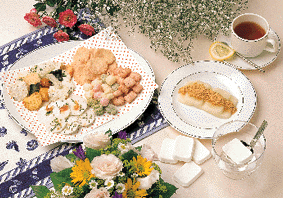
Health foods, emergency foods, rice-based confections,
etc. |
|||||||||||||||||||
| Company name | Hokuriku Seika Co., Ltd. |
|---|---|
| Address | 921 2-290-1 Oshino, Kanazawa Ishikawa Japan |
| Contact | Telephone number: 81-762-43-1000 Facsimile number: 81-762-44-6686 |
| Established | 1918 |
| Company representative | Mikio Takasaki |
| Trade representative | Shigeru Nishino |
| Number of employees | 98 |
| Products | Biscuits, dry bread, rice crackers |
 |
Yomiuri Newspaper: Words in the News |
|||||||
via my Other's Page. See this article here . |
||||||||
 |
Isawa : Sightseeing : Hot Springs : Local Cooking |
||||
Please visit the Isawa homepages |
|||||
 |
Round rice cake offered in September |
||

From Sizuoka Pages: |
|||
 |
Yubeshi |
||
|
|
|||
 |
3 Color Mochi |
||
|
|||
 |
Custard Mochi |
||
|
|||
 |
Custard Mochi #2 |
||
|
|||
 |
Mochi & Sekihan |
||
From: tzi1@slosh.com (Tzigane) Newsgroups: rec.food.recipes Subject: COLLECTION (3) Japanese Sweet Rice Recipes Date: 19 Nov 1997 20:04:36 -0700-MochiJapanese sweet rice is sometimes called Mochi [rice]. It [mochi] is also the name of rice cakes made with this sweet, sticky rice. Ohagi is a dumpling made with Domyoji mochi and bean paste. Most Mochi are made with Mochiko which is rice flour made from Mochi rice. Sekihan uses sweet rice as does one other dessert recipe I found. Mochi is a wonderful, sticky rice - much sweeter than American rice or even "Jasmine Rice" and very easy to cook. I found a few recipes with it as a main ingredient. Enjoy! |
|||
 |
Broiled Mochi wrapped in Nori |
||
Newsgroups: rec.food.recipes From: 606674@aisfin1.llnl.gov (Rick Millar) Subject: Mochi Organization: Lawrence Livermore National Lab Date: 4 Jan 1994 20:45:48 GMTHere are some recipes my mom used to make for me using Mochi. |
|||
 |
Kinako Mochi |
||
INGREDIENTS:
Combine Kinako and sugar. Put into a large shallow dish like a 9-inch pie pan. From: www.neosoft.com |
|||
| Join the Mochi Rice-Cake
Webring - Free - Easy - Fun
|
 |
||||||||||||||||
| Go To Page: | 1 | 2 | 3 | 4 | 5 | 6 | 7 | Mochidex |
| Scocasso! Index Page Copyright notice on index page |
This page hosted by Get your own Free Home Page |